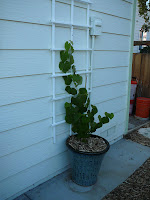Apply compost in early spring and again when fruits first form.
See page 94 of Rodale's Fruit for yearly pruning needs.
Cresthaven Red Haven Beautiful red-over-yellow fruit, with yellow flesh that’s firm yet melting and delicious. Early season, a favorite in our orchard for eating, canning and freeing. Very productive, needs thinning, has never failed to set a crop for us even in rainy weather. Non-showy flowers. Not for warm winters. (Trees of Antiquity)
Reliance Best choice for severely cold winters and springs (Trees of Antiquity) --available dwarfed from
Jung Seeds BOUGHT THIS ONE
Harken peach/Lovall rootstock -- This is the best flavored peach in our climate. From Canada, hardy and widely adapted. It is very sweet and bears a regular crop of large freestone peaches. For canning, pick fruit before it is table ripe. Ripens early August. Self fertile. Climate Zones: 5 to 9; pruning required to make it a dwarf
Frost peach -Pumi dwarf rootstock -- A flavorful, yellow fleshed peach good for canning or fresh eating. Semi-freestone. The longest tested curl resistant choice. Ripens mid-August. Self fertile. On the dwarfing pumi select rootstock. Climate Zones: 5 to 9
Mary Jane peach/Pumi dwarf rootstock -- A red skinned, yellow fleshed peach with showy pink flowers and very good flavor, It sets fruit even in frosty springs. It ripens mid August. It is good for fresh eating, drying, canning or freezing, A chance seedling selected by Louie Strahl in Steilacoom, WA. Climate Zones: 5 to 9
Shortest lived of the fruit trees- 10 to 15 years
Prune to an open vase (see Backyard Orchardist); pruning time dependant more on location than other tree types; peach tree pruning typically done in late winter or early spring; prune late (May 4th on my calendar) to allow frost damage assessment of buds and branches; remove wood that was freeze damaged and moderately prune the portion of the tree that still has live wood and buds; or if winter is mild, make thinning out cuts in late winter and possibly a few more after bloom, when the danger for frost damage to the flowers has passed.
Buds typically occur on lateral wood growth from the previous season; fruit buds appear as two plumb surrounding one vegetative bud; peaches and nectarines are typically self fertile; plant a couple of varieties to extent the harvest season
Peach trees produce many more fruit buds than necessary to produce abundant harvest; 10% of buds typically adequate; thin developing peaches about 6 to 8 weeks after bloom if cool, 4 to 6 weeks after bloom if warm.
Each peach needs 35 leaves to support its growth; consider when thinning developing fruits (Cool tidbit).
Split pit caused by insufficient moisture supplied to the developing fruit early in the season, followed by sudden abundant moisture; best remedy is a steady water supply
Light textured, well drained soils; susceptible to nematodes, viruses and bacterial diseases, and cold injury
Clingstone fruit flesh tends to be firm and smooth textured when canned; freestone flesh typically softer and have a slightly stringy texture when canned; no growing or care issues differ between the two types; early ripening varieties tend to be clingstone, while later ripening varieties tend to be freestone
Redhaven ripening date is commonly used as the reference to harvest date; those that mature before and up to a week later than Redhaven are termed early season varieties; midseason varieties mature up to two weeks later than Redhaven; late season varieties follow, ripening up to a month after Redhaven. If catalog provides info that looks like this…Candor (-19)…it means Candor ripens 19 days before Redhaven and would be considered an early season variety.
Winter hardy trees:
Belle of Georgia
Jefferson
Madison
Oldmixon Free
Pocahontas
Raritan Rose
Reliance (Trees of Antiquity)
Winter hardy fruit buds:
Belle of Georgia
Earliglo
McKay
Oldmixon Free
Raritan Rose
Reliance (Trees of Antiquity)
Average years to bearing – 4 years
Average yield per tree – 2 to 2 ½ bushels
Space needed per tree – 15 foot circle
Average mature height – 20 feet
Days from bloom to harvest – 60 to 120 days depending on variety
Pollination requirements – self-fruitful
Most common pruning system – open center
Commonly used rootstock – Halford or Lovell (standard tree)
Common insect pests – Oriental fruit moth, tarnished plant bug, curculio (weevil)
Common diseases – Brown rot, leaf curl, valsa canker, brown rot, bacterial spot
Useful life – 12 years
Number of trees for a family of four – 2 to 3 trees
Bears fruit on one year old wood





